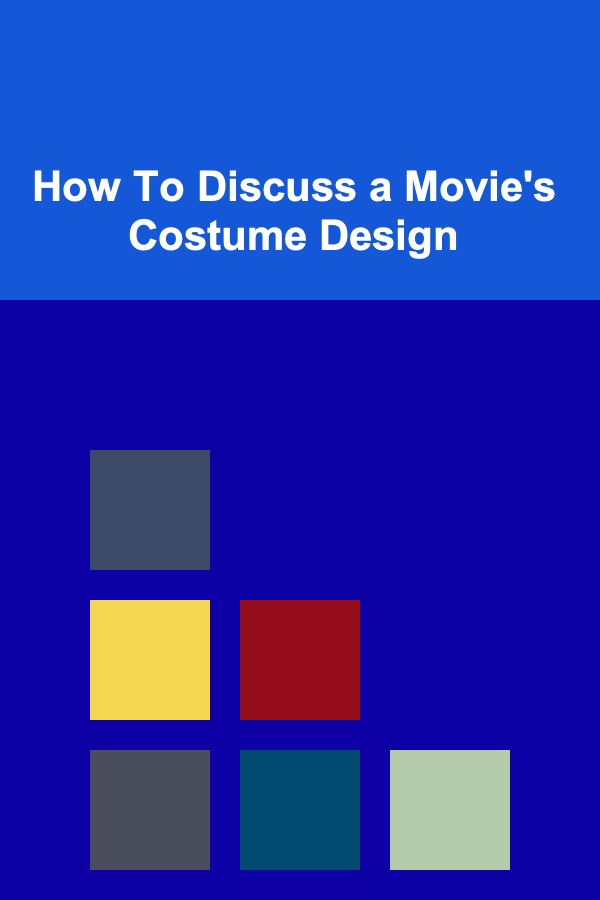
How To Discuss a Movie's Costume Design
ebook include PDF & Audio bundle (Micro Guide)
$12.99$9.99
Limited Time Offer! Order within the next:

When discussing a movie, one of the most important yet often overlooked aspects is the costume design. Costume design plays a crucial role in shaping the world of a film, helping to define characters, express themes, and influence the overall tone and atmosphere. The clothes worn by characters can speak volumes, sometimes conveying more than words ever could. Understanding how to discuss a movie's costume design requires recognizing its significance in the context of the film and knowing how to analyze the elements that contribute to its effectiveness. This guide will help you explore how to engage in a deep and meaningful discussion of costume design in film.
The Role of Costume Design in Filmmaking
Costume design is not merely about clothing; it is an essential storytelling tool in cinema. The costumes a character wears can reveal a great deal about their personality, social status, and even their inner conflict. Costume designers work closely with the director, production designer, and the rest of the creative team to create clothing that aligns with the narrative, characters, and themes of the film.
Expressing Character
One of the most significant contributions of costume design is character expression. The right outfit can instantly communicate important information about a character's background, occupation, and psychological state. For example, in a historical drama, a character's clothing might reflect the time period they are from, while in a superhero movie, a costume might symbolize their powers, ideology, or personal struggles.
In movies where the character undergoes significant growth or transformation, costume design can play a role in visually portraying that change. Think of how a costume evolves as a character does: A rebellious character might start in tattered, non-conformist attire, only to end up in more formal or refined clothing as they develop over the course of the film.
Setting the Tone and Atmosphere
Costumes also play a critical role in establishing the tone of a film. The choice of fabrics, colors, and styles can immediately set the mood for the entire narrative. A period piece, for example, might use historically accurate costumes to immerse the viewer in the past, while a futuristic sci-fi film might rely on sleek, modern designs to evoke a sense of innovation and progress.
Costumes can even create contrast within a movie. In a drama, for instance, the juxtaposition between the finely tailored attire of a wealthy character and the humble clothing of a working-class character can highlight class differences and social tensions, further enriching the narrative.
Reflecting Themes
Costumes are powerful tools for representing themes in film. A character's attire can reflect larger societal themes, such as power, oppression, freedom, and identity. In films like The Hunger Games, costume design is not only about making the characters visually appealing but also about reinforcing the themes of societal stratification, control, and rebellion.
In more abstract terms, costume design can also serve as a visual metaphor for internal conflicts or themes of transformation. For instance, a character in a dark, dystopian world may wear muted, utilitarian clothing, while the protagonist's gradual emergence into a leader might be symbolized through a gradual shift toward brighter, more regal clothing.
Symbolism and Costume as Metaphor
Costume designers often infuse their designs with symbolic meaning. For example, the color of a costume can have a significant impact on how a character is perceived. Red might symbolize passion or danger, blue could indicate calmness or sadness, and black could represent mystery or villainy. These symbolic colors often create an immediate connection with the audience, allowing them to understand a character's motivations or the emotional landscape they inhabit without the need for explicit dialogue.
In certain cases, the design itself can serve as a metaphor. For example, in The Matrix, the iconic black leather jackets and sunglasses worn by the protagonists evoke a sense of rebellion, secrecy, and coolness. The costume choices, along with the character's movements and actions, help reinforce the themes of freedom and resistance against an all-controlling system.
Key Elements to Analyze in Costume Design
When discussing a movie's costume design, there are several key elements to consider. A thorough analysis involves looking at the various aspects of the design and understanding how they work together to support the film's narrative.
1. Color Palette
The color palette of a film's costumes can play a significant role in shaping the audience's emotional response to the story. Colors can carry deep symbolic weight, and the strategic use of specific colors can underscore the themes and characters' emotional journeys.
- Warm Colors: Red, orange, and yellow are often used to convey passion, energy, danger, or heat. In action films or dramas, these colors might highlight moments of intense emotion or conflict.
- Cool Colors: Blue, green, and purple can represent calmness, sadness, or isolation. In a romance film, these colors might be used to convey a sense of yearning or melancholy.
- Monochromatic Palettes: When a film uses a singular color scheme for a character or group, it can symbolize uniformity or conformity. A film like The Hunger Games, where the districts are represented by specific colors in their clothing, uses this effect to emphasize class divisions.
2. Fabric and Texture
The fabrics and textures chosen for costumes can suggest a lot about the world of the film and its characters. Luxurious, shiny fabrics such as silk and velvet might indicate wealth or nobility, while rougher, coarser materials like wool or burlap could signify poverty or practicality. In a film set in a fantasy world, the materials used might be completely invented to evoke a sense of magic or mysticism.
Texture, too, can tell us a lot. A character who wears distressed or weathered clothing might be someone who has lived through hardship, while someone in immaculate attire might suggest a character who is privileged or vain. The tactile nature of the fabric helps build a deeper connection with the audience and adds layers to the characterization.
3. Silhouette and Shape
The overall shape and silhouette of a character's costume also convey important information. Tight-fitting clothing can indicate a character's physicality or confidence, while loose or flowing garments may suggest freedom, grace, or vulnerability. The cut of a costume can highlight or conceal certain parts of the body, influencing how the character is perceived by the audience.
In historical films, the silhouette can reflect the era in which the story is set. For instance, the long, flowing gowns and rigid corsets of the Victorian period speak to the societal constraints placed upon women at the time. Similarly, the sharp, structured lines of a business suit in a modern film may indicate professionalism, control, or rigidity.
4. Functionality and Practicality
A costume's functionality is another important aspect of costume design. In action or adventure films, the clothing must not only look visually interesting but also be practical for the demands of the story. A costume designed for a character who engages in combat must allow for movement and agility while still conveying their personality and role in the film.
In a science fiction film, a costume may have futuristic elements that enhance functionality, such as protective armor or gadgets. In these cases, the costume becomes an extension of the character's abilities and often reflects their technological or scientific environment.
5. Accessories and Details
Sometimes, the smallest details can make the biggest impact. Accessories such as jewelry, hats, gloves, or weapons can contribute significantly to the overall design of the character. A piece of jewelry, for example, might serve as a symbol of a character's wealth, status, or emotional state. A character's weapon might even function as an extension of their personality or inner struggles.
Small details like stitching, embroidery, or worn-out edges can provide subtle clues to a character's backstory. A coat with worn-out cuffs might indicate that the character is a traveler, while a meticulously clean suit might reveal a character's obsession with perfection or control.
6. Cultural and Historical Accuracy
In historical or culturally specific films, costume design plays a crucial role in ensuring the film's authenticity. A designer must pay careful attention to the historical and cultural context to ensure the costumes accurately reflect the period, place, and society depicted.
Historical accuracy, however, doesn't always mean creating replicas of actual clothing. Filmmakers might take creative liberties with costume design, blending historical accuracy with artistic interpretation to better suit the story or themes. For example, a film about Ancient Rome might feature historical tunics but modify them to reflect the director's artistic vision.
7. Character Development Through Costume
A well-designed costume often evolves with the character. The gradual change in a character's attire can symbolize their transformation throughout the film. In superhero movies, for example, the protagonist's costume might evolve from something simple or homemade to a more sophisticated and heroic version, signaling their journey from ordinary to extraordinary.
This transformation could be internal as well as external. A character who starts out wearing drab, muted colors might begin wearing brighter tones as they gain confidence or overcome personal obstacles. In this way, costume design becomes an integral part of the character's development and the film's emotional arc.
Conclusion
Costume design is a crucial element of filmmaking that often goes unnoticed by casual viewers but plays a critical role in shaping a film's narrative and emotional impact. It involves much more than just dressing the characters; it is a tool for storytelling, character development, and thematic exploration. A thorough discussion of a movie's costume design requires an understanding of how costumes communicate through color, fabric, silhouette, functionality, and symbolism. By considering these elements, one can appreciate the depth and complexity that costume design brings to the cinematic experience.
A well-designed costume is not just a visual accessory---it is a narrative device that helps tell the story in ways words alone cannot. When watching a film, pay attention to the costumes. They are not just there to beautify; they are there to enhance, to reveal, and to immerse you deeper into the world of the film.

How to Create a Minimalist Approach to School Supplies
Read More
How to Create a Safe Work Environment for DIY Projects
Read More
How to Evaluate Risk When Making Investment Decisions
Read More
How to Understand Rental Property Tax Deductions
Read More
How to Use Apps and Platforms to Get Transport Service Clients
Read More
How to Recognize Red Flags in Dating
Read MoreOther Products

How to Create a Minimalist Approach to School Supplies
Read More
How to Create a Safe Work Environment for DIY Projects
Read More
How to Evaluate Risk When Making Investment Decisions
Read More
How to Understand Rental Property Tax Deductions
Read More
How to Use Apps and Platforms to Get Transport Service Clients
Read More